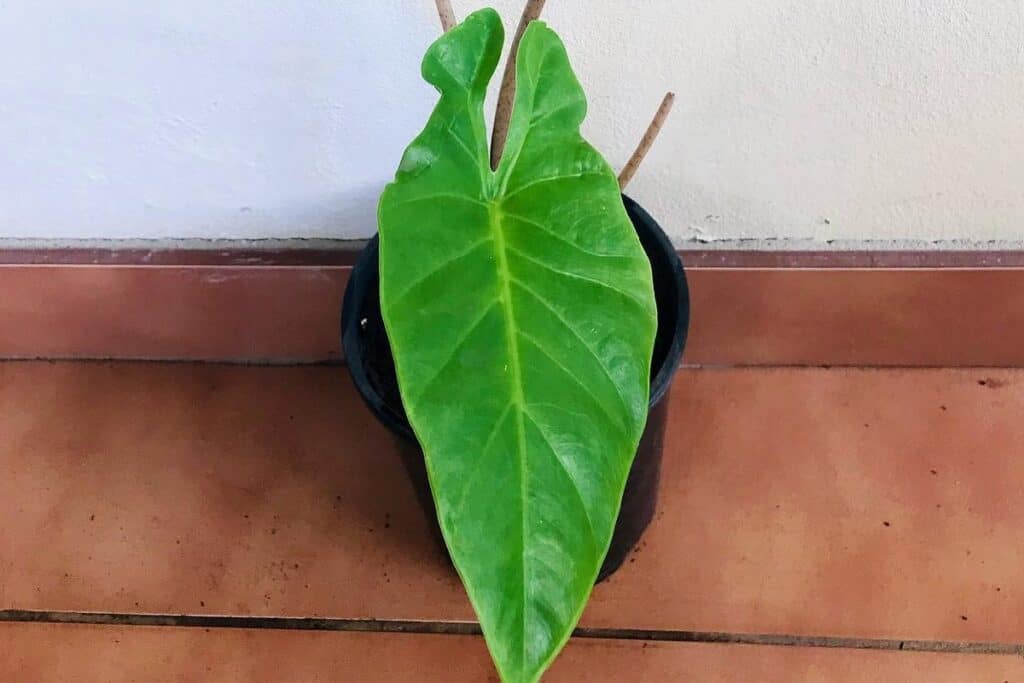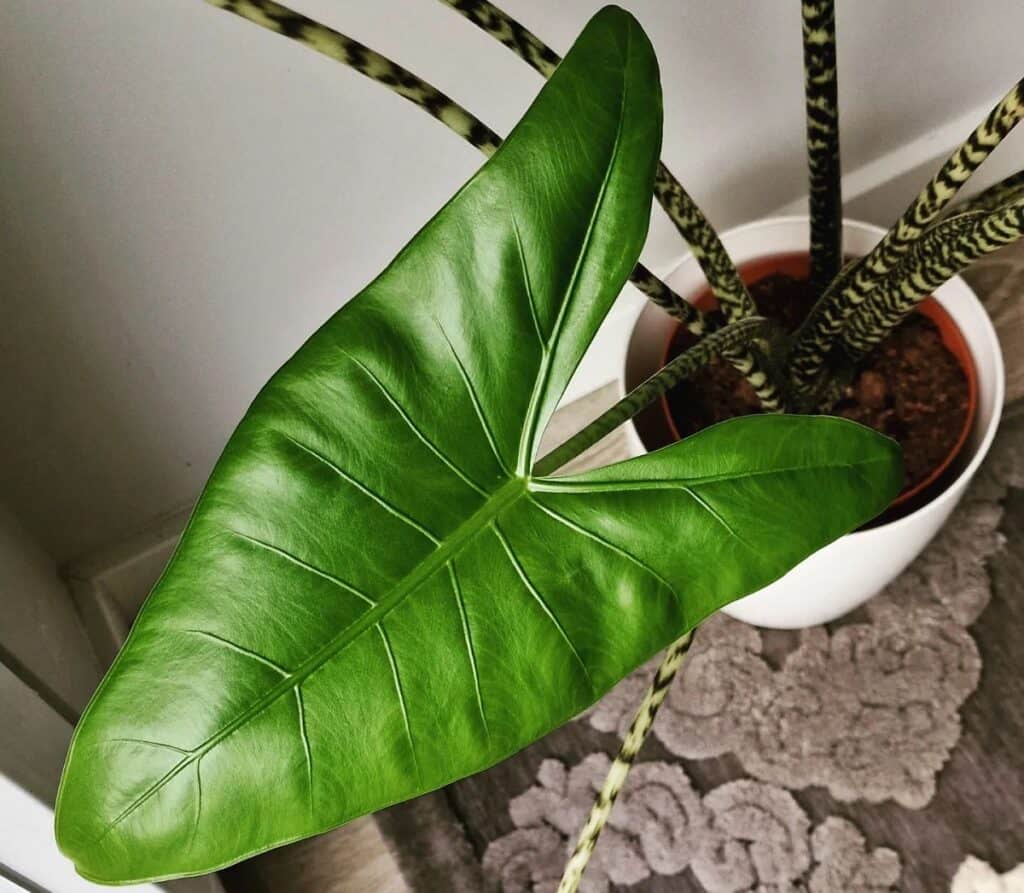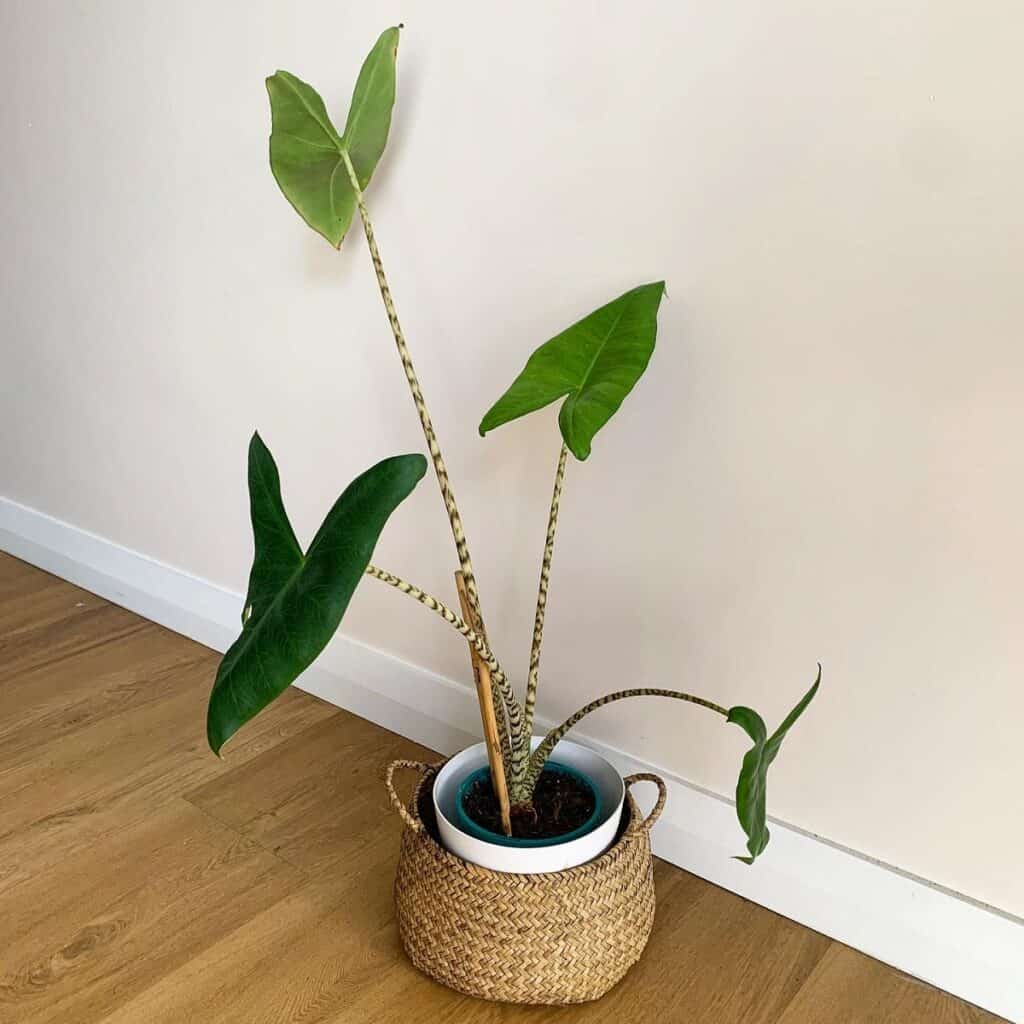Have you ever received a beautiful, exotic plant and marveled at its lush foliage only to find it wilting days later? This is the story of many Alocasia Zebrina owners. After working hard to create an inviting home for their new houseplant, they are left wondering “why is my Alocasia Zebrina drooping?”.
It’s like loving something so much that you give it your all yet still feel helpless when things go wrong. To get back on track with our beloved plants, we must first understand what causes them distress. Before diving into the details of your Alocasia Zebrina’s care regimen, let’s take a step back and look at the bigger picture.
Alocasia Zebrina plants thrive in tropical climates where there is consistent warmth and humidity—far from most homes during wintertime. When these conditions aren’t met, even simple mistakes can cause big problems—like droopy leaves or yellowing fronds. With proper understanding and care techniques, however, any gardener can keep their Alocasia Zebrina healthy and thriving!

Contents
Why Is My Alocasia Zebrina Drooping?
1. Underwatering
Have you ever wondered why your Alocasia Zebrina plant is drooping? It’s most likely because of underwatering. This lack of water causes the leaves to become yellow, and can lead to a dry condition in the soil which affects the moister level.
To help prevent this from happening, there are a few easy steps that you can take. First, make sure that your Alocasia Zebrina is placed in an area with indirect sunlight; direct sun exposure can cause it to dry out quickly. Second, check the moisture levels every day or two by sticking your finger into the soil; if it feels damp then no further watering is needed for now. Finally, water regularly but only when necessary—don’t overwater as that can be just as bad!
By following these tips, you’ll have less chance of experiencing any issues with your Alocasia Zebrina plants due to under-watering and will ensure they stay healthy and vibrant!
2. Overwatering
It’s important to pay attention to your plants, so it’s understandable why you’ve noticed the drooping of your Alocasia Zebrina. It could be a sign that there is too much water in the soil—this is known as overwatering. Excess water can cause droopy leaves and root rot, which will eventually lead to plant death if not taken care of quickly.
If this is indeed an issue with overwatering, then taking certain measures should help fix the problem.
First, check the potting soil for excessive wetness. If there’s standing water or extreme dampness present when you touch it, try changing out some of the soil for fresh soil and make sure that any new pot has drainage holes at the bottom to allow excess water to escape. Secondly, reduce the watering frequency until you notice more normal leaf shape and growth patterns start again. Make sure to keep track of how often you’re watering so as not to repeat mistakes made before!
3. Low Light Levels
Coincidentally, some of the same issues that cause an Alocasia Zebrina to droop can also be seen in other tropical plants. Low light levels is one such issue. If your Alocasia Zebrina isn’t getting enough indirect light or direct sunlight it may start to droop and look wilted. It’s important for these plants to get adequate daylight exposure—otherwise, they won’t thrive!
The second possible reason why your Alocasia Zebrina might be drooping is due to moisture level. To ensure optimal growth, you want a layer of soil that’s always lightly moist but never soggy or overly dry. Pay close attention to the moisture level in your plant’s potting mix and if needed, water it more frequently or less often depending on what it needs. By doing this, you should notice a positive change in your Alocasia Zebrina soon!

4. Poor Drainage
Drooping Alocasia Zebrina? All too familiar for those of us who have sought to grow the majestic elephant ear. Poor drainage could be a culprit behind this wilting symptom, and understanding how to care for our plants properly is key!
It’s important that the soil surface remains slightly dry—or else waterlogged soil can occur in soggy conditions. To ensure proper drainage, it’s best to use well-draining soils with ample aeration such as perlite or vermiculite. Substrates should also have an elevated pH level so that excess salts can flush out more easily. Additionally, when watering your Alocasia Zebrina make sure you do not overwater and keep the soil consistently moist but never overly wet. This way we can avoid any root rot due to poor draining conditions which will cause our beloved plant droopiness over time.
Overall, it’s essential to pay attention to the needs of your Alocasia Zebrina if you want it to remain healthy and happy. Proper drainage is one of the most important factors in providing optimal growing conditions for this plant species. Make sure you maintain good air circulation around its roots and take note of how often you are watering! With these simple steps, you’ll be able to give your Alocasia Zebrina just what it needs and enjoy its beauty without worry!
Related Post:
Best DIY Alocasia Soil Mix Recipe (Boosts Growth)
5. Lack Of Humidity
It’s natural to wonder why an Alocasia Zebrina might be drooping—poor drainage is often the culprit, but lack of humidity can also be a factor. A humid environment is integral for this plant to thrive. When relative humidity levels are low, Alocasia Zebrina plants become more vulnerable to pest infestations like spider mites and other diseases. To prevent these issues from occurring, it’s important to create a moist atmosphere in your home or office with the help of tools like humidity trays filled with pebbles and water.
For many people, keeping their plants healthy while maintaining a comfortable level of moisture in the air can seem daunting; however, by investing in a few simple solutions such as a humidity tray or misting bottle you can ensure that your Alocasia Zebrina plants stay happy and vibrant all year round! Just remember: when caring for any type of tropical houseplant, always strive to recreate its native climate as closely as possible. By providing adequate humidity along with proper watering and light requirements—you’ll have success growing beautiful Alocasia Zebrina plants indoors.
6. Temperature Shock
Temperature shock is another possible reason for your Alocasia Zebrina drooping. Transplant shock and cold temperatures can both cause extreme stress to the plant, making it vulnerable to disease or death if not handled correctly.
Here are 3 steps you should take to help reduce temperature shock in your Alocasia Zebrina:
- Gradually acclimate the plant to its new environment by slowly transitioning it from warm temperatures to cooler ones over a period of time.
- Keep the plant’s natural habitat in mind when deciding where to place it—this will ensure that any changes don’t come too suddenly and put undue stress on the Alocasia Zebrina.
- Provide consistent care—daily watering, misting with water and providing adequate sunlight will all contribute towards keeping your plant happy and healthy in its new home.
By following these tips, you’ll be able to create an ideal environment for your Alocasia Zebrina so that it won’t experience temperature shock from sudden changes in climate or surroundings. You’ll also make sure that your beloved pet stays safe and sound!

7. Incorrect Fertilizing
Do you have a drooping Alocasia Zebrina? It could be a case of incorrect fertilizing. Alocasia Zebrina plants are heavy feeders and need a fertilizer with water to get sufficient nutrients. They’re also picky when it comes to their water requirements, so make sure you check before giving them too much or too little!
A balanced fertilizer should do the trick for your Alocasia Zebrina. However, don’t go overboard — overfertilizing can burn the plant’s roots, making it even worse than when you started. If your Alocasia Zebrina is already drooping, try increasing its watering frequency and adding some fertilizer in order to save it!
In short, if your beloved Alocasia Zebrina is starting to look limp, give it an extra helping of balanced fertilizer and watch as it starts standing tall again.
8. Pest Infestations
If your Alocasia Zebrina is drooping, it could be an indication of a pest attack. Pests such as aphids, mites and mealybugs can sap the life out of plants by sucking their sap. These pests congregate in large numbers on plant foliage and can quickly cause damage if left unchecked.
There are several common signs of a pest infestation including discolored leaves, stunted growth or wilting. If you notice any of these symptoms then it’s time to take action! Insecticidal soaps are effective at getting rid of most small-scale infestations but for more severe cases, chemical pesticides may be necessary.
To ensure that your Alocasia Zebrina stays healthy, there are some steps you can take:
- Monitor regularly – Check your plants periodically for early detection of pests.
- Use natural remedies – Try using insecticidal soap or other home remedies like neem oil before resorting to stronger chemicals.
- Take preventive measures – Remove debris from around the base of the plant and make sure all cracks and crevices where pests might hide are sealed off.
For serious infestations, contact a professional who will be able to advise you on how best to protect your plants against further attacks. With regular monitoring and preventive measures in place, you should find that keeping your Alocasia Zebrina healthy is straightforward—just remember to act fast once you identify an issue!
9. Transplant Shock
Transplant shock is a major issue for any plant, which can cause drooping in Alocasia Zebrina. It’s especially common when plants are transferred from one pot to another or have recently been purchased. If the wrong time of year was chosen to transplant your Alocasia Zebrina, it will likely show signs of distress afterward, such as wilting and yellowing leaves.
Severe damage can result if the root system of your plant isn’t given enough time to adjust to its new home before being exposed to direct sunlight or high temperatures. This could mean that you’ll need to provide more water than usual until the roots establish themselves properly and allow the plant to grow again without droopy leaves.
TIP: Make sure you check with local gardeners about the best times of year to transplant so that you avoid putting your Alocasia Zebrina through unnecessary stress!

Pruning Drooping Leaves
It’s a fine line between keeping your Alocasia Zebrina healthy and giving it too much attention. Pruning drooping leaves is one way to make sure your plant stays in tip-top shape.
Pruning does more than just keep your plants looking their best; it also helps them stay healthy. Droopy plants can be caused by stress, pests, or even improper watering habits. Taking preventive measures like pruning away drooping leaves early on can help you avoid bigger problems down the road. When pruned correctly, you will end up with beautiful and healthy leaves that will last for many years to come.
Ensuring your Alocasia Zebrina has enough light, water, and fertilizer is essential to its health and growth. Regularly examining the appearance of the leaves can also give you a good idea of how well they are doing overall. If any issues arise, don’t hesitate to contact a professional who specializes in this type of plant care! With proper maintenance, you’ll have an Alocasia Zebrina that looks stunning all year round.
Tips For Preventing Drooping Alocasia Zebrina
Caring for an Alocasia Zebrina plant can be a tricky business—but with the right tips, you’ll have your drooping leaves standing tall in no time! Here are some pointers to avoid having your precious plant wilting away:
- Monitor humidity levels – Alocasia Zebrina plants require moist air and soil. If either becomes too dry, it could cause the leaves to start drooping.
- Provide proper care – Make sure that the pot has enough drainage holes at the bottom and provide adequate nutrition through fertilizing once a month during its growing season.
- Watch out for light conditions – Too much or too little light will put stress on the plant and result in limp leaves.
- Regulate temperature – Keep it between 65°F (18°C) and 80°F (27°C). Any temperatures outside of this range can lead to stunted growth and sagging foliage.
By following these simple steps, you’ll soon be able to enjoy lush green Alocasia Zebrina plants gracing your home all year round!
Conclusion
In conclusion, taking care of an Alocasia Zebrina can be tricky. There are many reasons why your plant may be drooping and it’s important to recognize the signs so that you can take proper action. I’ve outlined some of the most common causes for drooping in this article, but if none of these tips have worked then it might be time to consult a professional.
There is one surefire way to prevent drooping from happening: provide your Alocasia Zebrina with all the necessary conditions it needs to thrive. Make sure that you’re watering regularly without overwatering, providing enough light, making sure there is good drainage, adding humidity when needed and keeping pests away. All of these factors will help ensure that your Alocasia Zebrina stays healthy and happy!
Finally, don’t forget about pruning any droopy leaves as soon as possible—this will help keep them looking lush and green instead of limp and lifeless. By following these simple steps, you’ll be able to properly care for your beloved Alocasia Zebrina and avoid any further drooping issues in the future!
